Laying Down Laminate Flooring on Stairs: A Comprehensive Guide
Installing laminate flooring on stairs presents a unique challenge compared to standard floor installation. The process requires precision, careful measurement, and an understanding of the specific components designed for stair applications. This article provides a detailed guide to successfully laying laminate flooring on stairs, covering preparation, material selection, installation techniques, and safety considerations.
Understanding Laminate Flooring for Stairs
Laminate flooring, known for its durability and aesthetic appeal, is a popular choice for homes. When adapting it for staircases, it's crucial to understand the differences between standard planks and stair-specific components. Regular laminate planks are generally unsuitable for stair treads (the horizontal part you step on) because they lack a finished edge and the necessary thickness for structural support. Instead, specialized stair treads are manufactured with a bullnose edge—a rounded, finished edge—that provides a safer and more visually pleasing finish. These treads are also engineered to withstand the higher levels of foot traffic stairs endure.
In addition to treads, risers (the vertical part of the stairs) are required. These are typically made from thinner laminate material designed to complement the chosen stair tread. The riser material often matches the color and texture of the treads for a cohesive look. Transition pieces, such as quarter-round molding or stair nosing, are also essential for covering any gaps between the laminate and the existing trim or walls.
The selection of appropriate laminate flooring for stairs extends beyond aesthetics. Consider the slip resistance of the chosen material, especially for households with children or elderly individuals. Look for laminate flooring with a textured surface or a recognized anti-slip rating. Additionally, assess the thickness and density of the laminate, as thicker and denser materials offer improved durability and sound dampening, which is particularly beneficial on stairs.
Preparation and Material Acquisition
Proper preparation is paramount for a successful laminate stair installation. This involves cleaning and leveling the existing stairs, accurately measuring each stair, and gathering the necessary materials and tools.
Begin by thoroughly cleaning the existing stairs. Remove any carpet, padding, or old flooring. Scrape away any adhesive residue and repair any damage, such as cracks or loose boards. Use a leveling compound to ensure that each stair tread is perfectly level. This is crucial for preventing unevenness and potential tripping hazards in the future. Allow the leveling compound to dry completely according to the manufacturer's instructions.
Next, meticulously measure each stair. Stairs are rarely perfectly uniform, so each tread and riser must be measured individually. Measure the width and depth of each tread, and the height of each riser. It’s recommended to create a drawing of each stair with the measured dimensions. Add a small margin (approximately ¼ inch) to each measurement to account for minor variations and to allow for slight adjustments during installation. This extra material can be trimmed later if necessary.
Compile a comprehensive list of the required materials and tools. This includes: laminate stair treads, laminate risers, transition pieces (quarter-round molding or stair nosing), construction adhesive, wood screws (if required for extra stability), a measuring tape, a pencil, a circular saw or miter saw, a jigsaw (for intricate cuts), a level, a square, a rubber mallet, a tapping block, safety glasses, and ear protection.
When purchasing the laminate flooring and related materials, it's advisable to buy slightly more than what is calculated based on the measurements. This accounts for potential errors during cutting and installation, as well as the possibility of needing replacement pieces in the future due to damage.
The Installation Process: A Step-by-Step Guide
The installation process requires methodical execution and attention to detail. Starting with the top stair and working downwards is generally recommended, as this allows for easier access and movement during installation.
Begin by installing the riser. Apply construction adhesive to the back of the riser and carefully position it against the back of the stair. Ensure the riser is perfectly vertical using a level. If necessary, use shims to hold the riser in place while the adhesive dries. For added security, consider using wood screws through the riser into the underlying stair structure, particularly if the stairs are prone to movement or instability. Countersink the screw heads and fill the holes with wood filler to create a seamless finish.
Next, install the stair tread. Apply a generous amount of construction adhesive to the top of the existing stair tread. Carefully position the laminate stair tread on top of the adhesive, ensuring the bullnose edge aligns perfectly with the edge of the stair. Use a rubber mallet and tapping block to gently tap the tread into place, ensuring full contact with the adhesive. Again, for added stability, consider using wood screws, counter-sinking the heads and filling the holes.
Repeat this process for each stair, working from top to bottom. As you move down the staircase, continuously check the alignment and level of each tread and riser. Make any necessary adjustments before the adhesive fully sets. If you encounter stairs that require custom cuts due to angles or irregularities, use a jigsaw to carefully trim the laminate. Always prioritize safety by wearing safety glasses and ear protection when using power tools.
Once all the treads and risers are installed, focus on adding the transition pieces. These pieces serve to cover any gaps between the laminate and the surrounding walls or trim. Quarter-round molding is a common choice for this purpose. Apply construction adhesive to the back of the molding and carefully position it along the edge of the laminate. Use finishing nails to secure the molding in place. Stair nosing can also be used, especially at the bottom stair where the laminate meets the floor.
Addressing Common Challenges and Ensuring Safety
Laying laminate flooring on stairs can present several challenges. Uneven stairs, complex angles, and ensuring a secure and slip-resistant surface are common concerns. Proper planning and attention to detail can mitigate these issues.
When dealing with uneven stairs, shimming is essential. Shims are thin pieces of material (typically wood or plastic) that are used to level the surface. Place shims strategically under the riser or tread to compensate for any unevenness. Ensure the shims are securely attached to prevent them from shifting over time.
For stairs with complex angles or irregular shapes, creating templates can be helpful. Use cardboard or paper to trace the outline of the stair. Carefully cut out the template and use it as a guide for cutting the laminate. This ensures a precise fit, even in challenging situations.
Prioritizing safety is paramount throughout the entire installation process. Always wear safety glasses and ear protection when using power tools. Use a dust mask to avoid inhaling dust particles. Ensure the work area is well-ventilated. When cutting laminate, use a sharp blade and a stable work surface. Avoid rushing the process and take frequent breaks to prevent fatigue. A rushed installation can lead to errors and potentially compromise the safety and stability of the stairs.
Beyond the physical installation, maintaining the laminate flooring on stairs is crucial for longevity and safety. Regularly vacuum or sweep the stairs to remove dirt and debris. Clean spills immediately with a damp cloth. Avoid using excessive water or harsh chemicals, as these can damage the laminate. Consider using a non-slip stair tread tape or mats for added safety, especially in high-traffic areas or households with young children or elderly individuals. Regularly inspect the laminate for any signs of damage, such as chips, scratches, or loose pieces. Repair any damage promptly to prevent further deterioration and maintain the safety of the stairs.

How To Install Laminate Flooring On Stairs Direct Wood

How To Install Laminate Flooring On Staircase Step By Guide

Can You Laminate Stairs The Pros Cons

How To Install Laminate Flooring On Stairs 13 Steps

How To Install Laminate Flooring On Stairs Direct Wood

Value Carpets Flooring Installing Laminate On Stairs

How To Install Vinyl Plank Flooring On Stairs In 6 Steps Inc

How To Install Laminate Flooring On Stairs 13 Steps

How To Install Laminate Flooring On Stairs As A Beginner Stair Noses Step By Short

How To Install Laminate Flooring On Stairs Direct Wood
Related Posts








